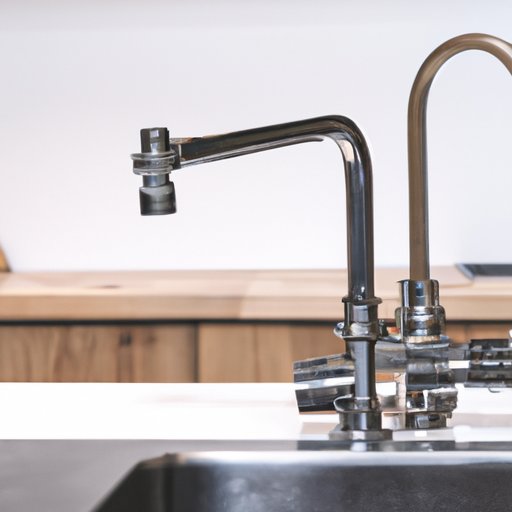
Introduction
Are you tired of your old, leaky kitchen faucet? Replacing a kitchen faucet might seem like a daunting task, but with the right tools and guidance, it can be a straightforward DIY project. In this article, we will guide you through the step-by-step process of replacing your kitchen faucet, so you can enjoy a new and improved sink without breaking the bank.
Step-by-Step Guide: How to Replace Your Kitchen Faucet Like a Pro!
Here is a list of the tools you will need to replace your kitchen faucet:
- Pipe wrench
- Basin wrench
- Adjustable wrench
- Plumber’s putty
- Teflon tape
- Screwdrivers
Once you have gathered all the necessary tools, follow these steps:
- Turn off the water supply
- Disconnect the supply lines
- Remove the old faucet
- Prepare the sink for the new faucet
- Install the new faucet
The water shutoff valves for your sink are usually located underneath the sink. Turn off both the hot and cold water supply to the sink by twisting the valves clockwise.
Use a wrench to unscrew the nuts that hold the supply lines in place.
Use a basin wrench to loosen and remove the mounting nuts that secure the faucet to the sink. Once the nuts have been removed, lift the old faucet off the sink.
Clean the sink surface thoroughly and remove any old plumber’s putty or debris. Apply a new layer of plumber’s putty around the base of the new faucet, then position the new faucet into place.
Tighten the mounting nuts underneath the sink to secure the new faucet to the sink. Reconnect the supply lines, and turn the water supply back on.
DIY Kitchen Faucet Replacement in 5 Easy Steps
Some people may prefer to replace their kitchen faucet on their own without professional help. If that’s you, follow these five easy steps:
- Remove the old faucet
- Clean the sink and add plumber’s putty
- Install the base plate and new faucet
- Connect the supply lines
- Turn on the water supply
Following these simple steps will ensure that your new faucet is installed safely and securely.
When to Replace Your Kitchen Faucet and How to Pick the Right One
If you notice any of the following signs, it’s time to replace your kitchen faucet:
- Leaking
- Low water pressure
- Corrosion
- Difficult to turn on or off
Choosing the right replacement faucet can be overwhelming. Faucets come in a variety of styles and finishes, so it’s important to consider your personal preferences and kitchen design. Some popular faucet styles include:
- Pull-down faucet
- Single-handle faucet
- Touchless faucet
- Bridge faucet
When picking a faucet, also consider how it will fit into your sink and the number of holes in your sink.
Troubleshooting when you replace Kitchen Faucet
Sometimes things don’t go as smoothly as they should. If you encounter any of the following problems when replacing your kitchen faucet, here’s how to fix them:
- Leaky pipes – In this case, you may need to replace the pipes entirely, or you can try tightening the nuts connecting the supply lines.
- Damaged fixtures – Damaged fixtures, like a bent or broken pipe, need to be replaced.
- Hard-to-remove faucet – Try using a penetrating oil to loosen the nuts, or carefully apply heat to help loosen any corrosion.
Sustainability & Style: Replace Your Kitchen Faucet with a Modern Touch
Replacing your kitchen faucet might seem like a minor project, but it can have a significant impact on the style and sustainability of your kitchen. When choosing a new faucet, consider options like low-flow models or touchless faucets, which can help reduce water usage and save you money on your water bill.
Fortunately, modern faucets come in various styles and finishes. You can choose from classic chrome and stainless steel to more modern finishes, such as matte black or brushed gold. Consider your countertops, cabinets, and overall kitchen design when selecting the style and finish of your new faucet.
Is It Time to Enhance Your Kitchen? How to Replace Your Kitchen Faucet in Under 30 Minutes
Replacing your kitchen faucet is a quick and easy way to update your kitchen’s look without breaking the bank. If you’re looking for additional ways to enhance your kitchen, consider the following:
- Painting your cabinets
- Updating your lighting fixtures
- Replacing your hardware
- Adding a backsplash
By tackling these smaller projects, you can achieve significant results without investing too much time or money.
Conclusion
Congratulations! You have learned how to replace your kitchen faucet like a pro. Remember to turn off the water supply before starting, and follow the step-by-step instructions we provided. Don’t forget to troubleshoot any issues you might face and consider sustainability and style when picking out your new faucet. By following our guidance, you can successfully replace your kitchen faucet and update your kitchen’s overall look and feel.





